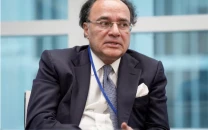Health issues: Good news at last as efforts against TB starting to pay off says Report
In contrast, the number of HIV cases continues to rise.

The study, titled 'Global, regional, and national incidence and mortality for HIV, tuberculosis, and malaria during 1990-2013: a systematic analysis for the Global Burden of Disease Study 2013' was conducted by an international consortium of researchers led by the Institute for Health Metrics and Evaluation at the University of Washington.

From 2000 to 2013, Pakistan averaged a 15 per cent annual increase in rates of new HIV/AIDS infections, rising from less than one case per 100,000 to 6.7 per 100,000. Far more Pakistanis die from TB each year [nearly 37,500 were killed by TB in 2013], but Pakistan's ongoing efforts to reduce TB mortality rates starkly contrast with its burgeoning HIV/AIDS burden, says the report.
After adjusting for differences in population size and ages across time, researchers found that there were 277 cases of TB per 100,000 people in Pakistan in 2013. In terms of new cases, Pakistan recorded 151 TB cases per 100,000 that year.
At 1.5 per 100,000, death rates from HIV/AIDS in Pakistan were higher than in Afghanistan and Iran for 2013 [each was less than 1 death per 100,000]. The figure was, however, lower than in India [6.6 deaths per 100,000]. The TB death rates in Pakistan, 32 deaths per 100,000, were also lower than that in India - 58 deaths per 100,000.
"Working closely with the World Health Organisation, Pakistan has prioritised tackling tuberculosis and malaria and I think we are seeing what happens when you invest in improving the prompt diagnosis and treatment of these deadly diseases," said Prof Zulfiqar Bhutta, the founding director of the Centre of Excellence in Women and Child Health at the Aga Khan University and one of the study's co-authors. "We now need to make sure HIV/AIDS does not take any more lives in Pakistan," he added.
Commenting on the major reason for the increase of HIV/AIDS cases, he said, "The stipulated increase in Pakistan is based on a combination of factors: the increase in the incidence of disease among drug users and other high-risk categories such as sex workers and their clients," he explained, adding that a slackening of preventive measures were also causing the increase. Prof Bhutta stressed that the AIDS programme needs a complete revamping with a review of services and strategies.
The programme manager of the Sindh Enhanced HIV/Aids Control Programme, Dr Muhammad Nafees Qureshi, was of the belief that the number of patients had not increased, rather more cases have been reported due to increased awareness. "People were not coming out with their diseases. Now, not only the patients, even their family members are aware of the disease and know that treatment is available," he explained.
"The cases will decrease in the coming years as more people are taking the necessary precautions for prevention, due to steps such as awareness drives."
Suggesting ways to control HIV/AIDS deaths in Pakistan, Prof Bhutta said that much more could be done in terms of community education, with particular emphasis on high-risk groups such as sex workers, addressing injectable drug use and preventing mother-to-child transmission. "We need to completely stamp out commercial blood donation and streamline screening services for Hepatitis B and C as well as HIV."
Dr Abdul Ghafoor Shoro, the chest specialist and the joint secretary of the College of Family Medicine, Pakistan, was shocked to know of the decrease in TB cases in the country. "It is a good news for Pakistan, but very strange as well." He believed that the reason for the decrease was the availability of the medicine. "More importantly, the medicine is available at cheaper rates."
Published in The Express Tribune, July 23rd, 2014.



















COMMENTS
Comments are moderated and generally will be posted if they are on-topic and not abusive.
For more information, please see our Comments FAQ